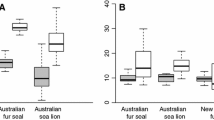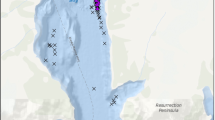Abstract
We examined the effect of hypoxia on the swimming speed, respiration rate (oxygen uptake), gape and ventilation volume of the bonnethead shark, Sphyrna tiburo. We used a sonic flowmeter developed for this study to examine swimming speed changes of sharks held in artificial lagoons during diurnal dissolved oxygen changes. Sharks were observed to swim at about 34 cm s-1 during the day but increased to about 40 cm s-1 at night when dissolved oxygen levels fell to < 3 mg l-1. Using a closed system respirometer we examined changes in swimming speed, respiration rate and gape at four dissolved oxygen levels. Swimming speeds averaged 24 to 25 cm s-1 under normoxic conditions but increased to 38 to 40 cm s-1 during hypoxia. Similarly, respiration rate increased with increasing speed and decreasing dissolved oxygen. Gape averaged about 1.0 cm under normoxic conditions and increased to a maximum of about 3.5 cm during hypoxia. Using assumed oxygen extraction efficiencies of 25, 50 and 75% and observed respiration rates, we estimated that ventilation volumes of about 25 to 470 l h-1, depending upon oxygen concentration, would be necessary for gill ventilation. These experiments suggest that changes in swimming speed and mouth gape are important for respiratory regulation in ram ventilating sharks.
Similar content being viewed by others
References
Blaylock, R.A. 1990. Effects of external biotelemetry transmitters on behavior of the cownose ray, Rhinoptera bonasus. J. Exp. Mar. Biol. Ecol. 141: 213-220.
Brill, R.W. 1996. Selective advantages conferred by the high performance physiology of tunas, bill fishes, and dolphin fish. Comp. Biochem. Physiol. 113A: 3-15.
Bushnell, P.G. and Brill, R.W. 1991. Responses of swimming skipjack Katsuwonus pelamis and yellowfin Thunnus albacares tunas to acute hypoxia, and a model of their cardiovascular function. Physiol. Zool. 64: 787-811.
Bushnell, P.G. and Jones, D.R. 1994. Cardiovascular and respiratory physiology of tuna: adaptations for support of exceptionally high metabolic rates. Env. Biol. Fish. 40: 303-318.
Dizon, A.E. 1977. Effect of dissolved oxygen concentration and salinity on swimming speed of two species of tunas. Fish. Bull. 75: 649-653.
Dizon, A.E., Neill, W.H. and Magnuson, J.J. 1977. Rapid temperature compensation of volitional swimming speeds and lethal temperatures in tropical tunas (Scombridae). Env. Biol. Fish. 2: 83-92.
Gooding, R.M., Neil, W.H. and Dizon, A.E. 1981. Respiration rates and low-oxygen tolerance limits in skipjack tuna, Katsuwonus pelamis. Fish. Bull. 79: 31-48.
Gruber, S.H. 1984. Bioenergetics of the captive and free ranging lemon shark, Negaprion brevirostris. Ann. Proc. Am. Ass. of Zoological Parks and Aquariums. pp. 341-373. Wheeling, W. Virginia.
Gruber, S.H., Nelson, D.R. and Morissey, J. 1988. Patterns of activity and space utilization of lemon sharks, Negaprion brevirostris, in a shallow Bahamian lagoon. Bull. Mar. Sci. 43: 61-77.
Hobson, E.S. 1968. Predatory behavior of some shore fishes in the Gulf of California. Fish. Bull. 72: 915-1031.
Hopkins, T.E. and Cech, J.J. 1995. Temperature effects on blood-oxygen equilibria in relation to movements of the bat ray, Myliobatis californica in Tomales Bay, California. Mar. Behav. Physiol. 24: 227-235.
Klimley, A.P., Anderson, S.D., Pyle, P. and Henderson, R.P. 1992. Spatiotemporal patterns of white shark, Carcharodon carcharias predation at the South Farallon Islands, California. Copeia 3: 680-690.
Lenfant, C. and Johansen, K. 1966. Respiratory function in the elasmobranch Squalus suckleyi G. Resp. Physiol. 1: 13-29.
Limbaugh, C. 1963. Field notes on sharks. In Sharks and Survival. pp. 63-64. Edited by P.W. Gilbert. D.C. Heath and Co., Boston.
Lowe, C.G. 1996. Kinematics and critical swimming speed of juvenile scalloped hammerhead sharks. J. Exp. Biol. 199: 2605-2610.
Magnuson, J.J. 1973. Comparative study of adaptations for continuous swimming and hydrostatic equilibrium of scombrid and xiphoid fishes. Fish. Bull. 71: 337-356.
Magnuson, J.J. 1978. Locomotion by scombroid fishes: Hydromechanics, morphology, and behavior. In Fish Physiology. Vol. VII, pp. 239-313. Edited by W.S. Hoar and D.J. Randall. Academic Press, New York.
Metcalf, J.D. and Butler, P.J. 1984. Changes in activity and ventilation response to hypoxia in unrestrained, unoperated dogfish, Scyliorhinus canicula L. J. Exp. Biol. 108: 411-418.
Nelson, D.R. and Johnson, R.H. 1970. Diel activity rhythms in the nocturnal, bottom-dwelling sharks, Heterodontus francisci and Cephaloscylium ventriosum. Copeia 4: 732-739.
Nixon, A.J. and Gruber, S.H. 1988. Diel metabolic activity patterns of the lemon shark, Negaprion brevirostris. J. Exp. Zool. 248: 1-6.
Parsons, G.R. 1987. Life History and Bioenergetics of the Bonnethead Shark, Sphyrna tiburo (Linnaeus): A Comparison of Two Populations. Ph.D. Dissertation, University of South Florida at St. Petersburg, USA.
Parsons, G.R. 1990. Metabolism and swimming efficiency of the bonnethead shark, Sphyrna tiburo. Mar. Biol. 104: 363-367.
Parsons, G.R. 1991. Activity patterns of the bonnethead, Sphyrna tiburo. J. Aquaricult. Aquat. Sci. 4: 8-13.
Piper, J and Schumann, D. 1967. Efficiency of oxygen exchange in the gills of the dogfish, Scyliorhinus stellaris. Resp. Physiol. 2: 135-148.
Randall, D.J. 1970. The circulatory system. In Fish Physiology. Vol. IV, pp. 133-168. Edited by W.S. Hoar and D.J. Randall, Academic Press, NewYork.
Smit, H., Amelink-Koutstaal, J.M., Vijverberg, J. and von Vaupel-Klein, J.C. 1971. Oxygen consumption and efficiency of swimming goldfish. Comp. Biochem. Physiol. 39A: 1-28.
Springer, S. 1963. Field observations of large sharks of the Florida-Caribbean region. In Sharks and Survival. pp. 95-114. Edited by P.W. Gilbert. D.C. Heath and Co., Boston.
Rights and permissions
About this article
Cite this article
Parsons, G., Carlson, J. Physiological and behavioral responses to hypoxia in the bonnethead shark, Sphyrna tiburo: routine swimming and respiratory regulation. Fish Physiology and Biochemistry 19, 189–196 (1998). https://doi.org/10.1023/A:1007730308184
Issue Date:
DOI: https://doi.org/10.1023/A:1007730308184




